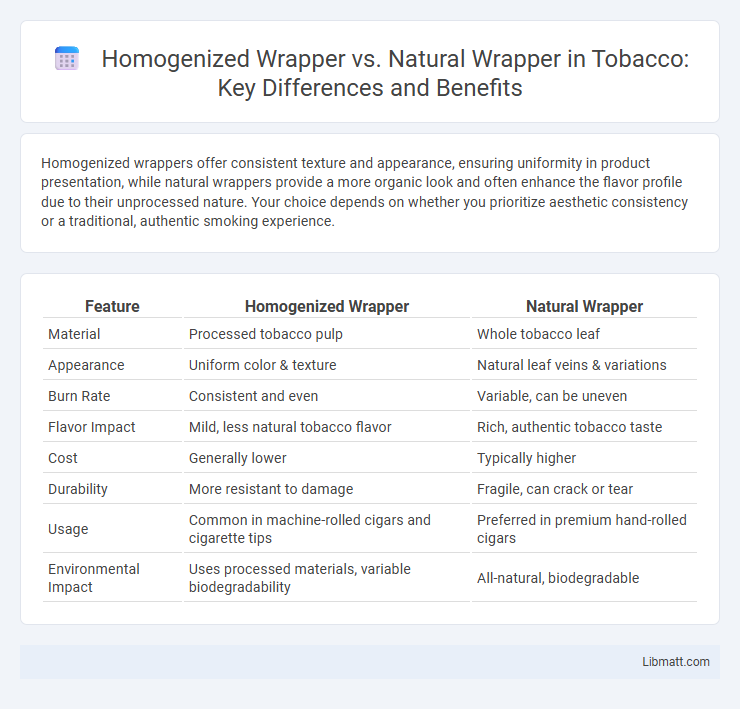Homogenized wrappers offer consistent texture and appearance, ensuring uniformity in product presentation, while natural wrappers provide a more organic look and often enhance the flavor profile due to their unprocessed nature. Your choice depends on whether you prioritize aesthetic consistency or a traditional, authentic smoking experience.
Table of Comparison
| Feature | Homogenized Wrapper | Natural Wrapper |
|---|---|---|
| Material | Processed tobacco pulp | Whole tobacco leaf |
| Appearance | Uniform color & texture | Natural leaf veins & variations |
| Burn Rate | Consistent and even | Variable, can be uneven |
| Flavor Impact | Mild, less natural tobacco flavor | Rich, authentic tobacco taste |
| Cost | Generally lower | Typically higher |
| Durability | More resistant to damage | Fragile, can crack or tear |
| Usage | Common in machine-rolled cigars and cigarette tips | Preferred in premium hand-rolled cigars |
| Environmental Impact | Uses processed materials, variable biodegradability | All-natural, biodegradable |
Understanding Homogenized Wrappers: An Overview
Homogenized wrappers are synthetic casings created by blending natural fibers with collagen or cellulose, offering consistent thickness and enhanced durability for food products. These wrappers provide reliable moisture retention and uniform cooking, making them ideal for processed meats and sausages. Understanding the composition and benefits of homogenized wrappers helps manufacturers select suitable casings that improve product quality and extend shelf life.
What Defines a Natural Wrapper?
A natural wrapper is defined by its use of the tobacco leaf or other organic plant material that undergoes minimal processing, preserving original texture, flavor, and characteristics. It contributes to a richer, more authentic taste experience and burns slower compared to homogenized wrappers. Natural wrappers are preferred by aficionados seeking a pure tobacco flavor and traditional craftsmanship in cigars.
Composition and Manufacturing Process
Homogenized wrappers are made by blending natural tobacco leaves and reconstituted tobacco with additives to create a uniform, consistent texture and appearance, using processes such as slurry formation and paper-making techniques. Natural wrappers consist of unaltered tobacco leaves that are carefully selected, cured, and fermented to preserve their original texture and flavor profiles. Your choice between homogenized and natural wrappers impacts the cigarette's burn rate, flavor delivery, and overall smoking experience due to these distinct composition and manufacturing differences.
Flavor Profiles: Homogenized vs Natural Wrappers
Homogenized wrappers offer consistent flavor profiles with smooth, mild tobacco notes due to their processed nature, ensuring uniformity across cigars. Natural wrappers provide complex and varied flavor experiences influenced by their organic growing conditions, often resulting in richer, earthier, or spicy tones. Your choice between homogenized and natural wrappers significantly impacts the depth and authenticity of the cigar's overall taste.
Appearance and Texture Differences
Homogenized wrappers provide a uniform appearance with a smooth, consistent texture that enhances visual appeal and ensures even burn quality. Natural wrappers exhibit varied colors and textures, reflecting organic leaf veins and imperfections that create a more rustic and tactile experience. Your preference for a flawless look or authentic feel will influence the choice between these two wrapper types.
Smoking Experience and Burn Quality
Homogenized wrappers provide a consistent and uniform burn, ensuring a smooth smoking experience without unexpected runs or uneven ash. Natural wrappers, derived from whole tobacco leaves, offer a richer flavor profile and a more authentic taste but may burn less evenly due to natural variations in leaf texture and thickness. Your choice between these wrappers impacts both the burn quality and overall enjoyment, with homogenized wrappers favoring reliability and natural wrappers emphasizing traditional flavor complexity.
Health and Additive Considerations
Homogenized wrappers undergo processing that includes additives to maintain consistency and enhance shelf life, potentially introducing chemicals that may affect health. Natural wrappers are minimally processed, preserving organic compounds and reducing exposure to synthetic additives, which some consumers prefer for a cleaner smoking experience. Health-conscious users often choose natural wrappers to avoid additives linked to respiratory irritation and other adverse effects.
Cost and Accessibility Comparison
Homogenized wrappers generally cost less due to mass production techniques, increasing their accessibility for budget-conscious consumers. Natural wrappers, often made from whole tobacco leaves, tend to be more expensive because of the careful harvesting and curing processes involved. The higher price of natural wrappers may limit their availability, while homogenized options remain widely accessible in most markets.
Popular Products Using Each Wrapper Type
Popular products using homogenized wrappers include Swisher Sweets and Dutch Masters, known for their smooth, consistent texture created by blending tobacco leaves and reconstituted tobacco. Natural wrappers are commonly found in premium cigars like Arturo Fuente and Padron, prized for their authentic tobacco leaf construction that delivers richer flavors. Each wrapper type caters to different consumer preferences, with homogenized wrappers favored for affordability and consistency, while natural wrappers appeal to connoisseurs seeking traditional craftsmanship and complexity.
Choosing the Right Wrapper for Your Preferences
Selecting between a homogenized wrapper and a natural wrapper depends on desired flavor intensity and smoking experience. Homogenized wrappers offer consistency and smoothness by blending tobacco leaves and additives, appealing to smokers seeking a mild, even burn. Natural wrappers, made from whole tobacco leaves, provide robust flavor profiles and a traditional feel, preferred by those valuing authenticity and stronger taste.
homogenized wrapper vs natural wrapper Infographic

 libmatt.com
libmatt.com